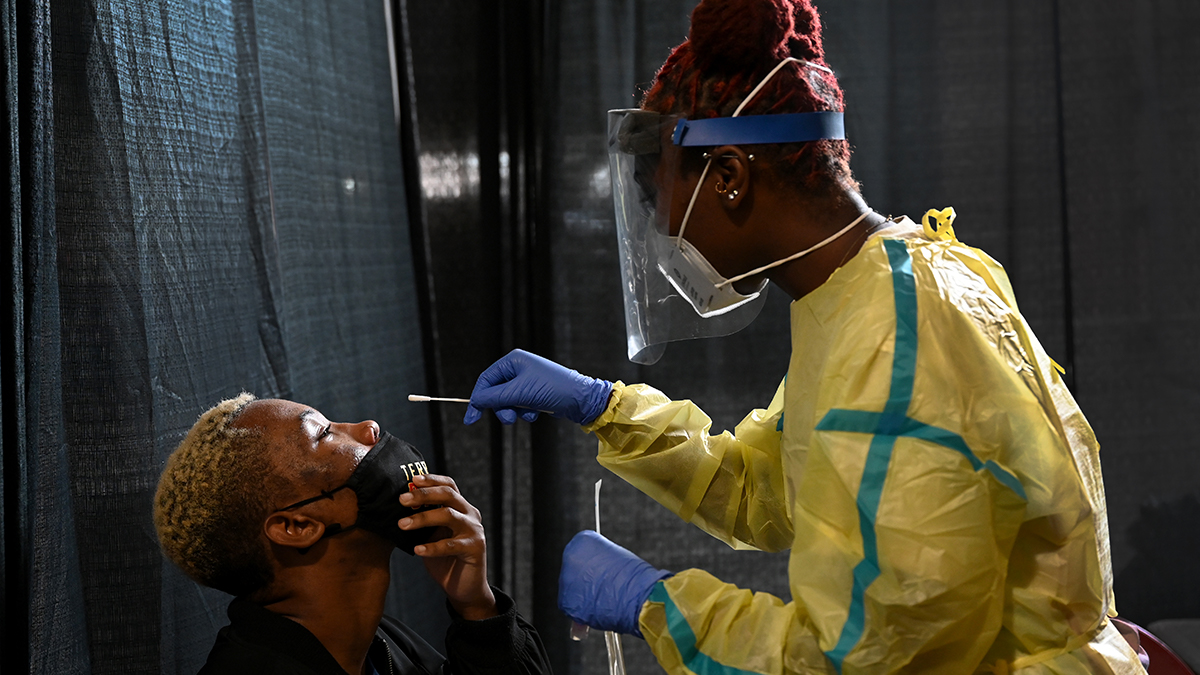More people are donning masks and boarding planes, even as COVID-19 cases continue to rise throughout the U.S.
The Transportation Security Administration (TSA) announced Monday the number of passengers screened in a single day for flights nationwide topped one million on Sunday, the highest number of passengers since the onset of the pandemic in March.
The TSA also said that six million passengers were screened at checkpoints in the U.S. during the week of Oct. 12 through Oct. 18, setting another milestone.
“TSA has been diligent in our efforts to ensure checkpoints are clean, safe and healthy for frontline workers and airline passengers,” said TSA Administrator David Pekoske.
We're making it easier for you to find stories that matter with our new newsletter — The 4Front. Sign up here and get news that is important for you to your inbox.
For D.C. residents, however, traveling to most places comes with a price – a 14-day self-quarantine period.
D.C.’s health department added eight states to the high-risk list early Monday: Arizona, Colorado, Connecticut, Massachusetts, Michigan, Ohio, Pennsylvania and Rhode Island.
This brings D.C.'s list of high-risk states requiring quarantine to a total of 39.
While some are opening up to the idea of traveling for the holidays, public health experts like Andrew Noymer, a professor at the University of California, Irvine, still urge caution and suggest staying home.
"When people move all around the country, they bring their microbes with them," Noymer said in an interview with LX News.
"So, I'm worried about people traveling from higher prevalence regions to lower prevalence regions and bringing the virus with them."
In Fairfax County, for the first time since March, some students head back into school as a pilot program with concurrent learning begins Monday. Students in schools and at home will get the same live instruction.
“It’s kind of an experiment,” county Federation of Teachers President Tina Williams told News4’s Justin Finch. “Lives are at stake.”
On Capitol Hill, delays in Congress could mean that coronavirus relief won't be delivered before the election. Republicans and Democrats are hashing out the details, but a deal would have to be realized by Tuesday for it to be enacted by Election Day.
Here's where we stand as the coronavirus continues to change our lives in D.C., Maryland and Virginia:
What the Data Shows
The total number of confirmed COVID-19 cases worldwide topped 40 million Monday morning, according to a count from Johns Hopkins University.
Although cases are on the rise nationally, there are some hints that the recent surge of cases in the D.C.-area is beginning to slow down.
D.C.'s seven-day case average (53) is down by 15 compared to last week. Seven-day averages in Maryland (613) and Virginia (874) are still high, but they have leveled off over the past few days.
D.C. reported 25 cases on Monday and no additional deaths. Maryland reported 497 more cases and four additional deaths. Virginia had 601 new cases and 13 additional deaths.
The positivity rates in our region are a little higher than usual with D.C., Maryland and Virginia reporting rates of 2%, 3.14% and 5%, respectively.
The map below shows the number of coronavirus cases diagnosed per 100,000 residents.
Coronavirus Cases in DC, Maryland and Virginia
COVID-19 cases by population in D.C. and by county in Maryland and Virginia
Source: DC, MD and VA Health Departments
Credit: Anisa Holmes / NBC Washington
Local Coronavirus Headlines
- A group of teachers for D.C. Public Schools rallied over the weekend to voice their concerns about a plan to go back to in-person instruction in November.
- Most new COVID-19 cases in D.C. come from social events, according to data presented Wednesday by the District's health department.
- Montgomery County could roll back reopening after seeing an increase in infections.
- Five employees of the Maryland Motor Vehicle Administration tested positive for COVID-19 and one of them has died, officials say.
- The Fauquier County School Board expects 71% of its students back in classrooms as part of a hybrid learning plan starting Nov. 9.
- Child care capacity is expanding in Maryland under phase three, although Montgomery and Prince George's counties opted to remain at current operating levels.
- Gym goers in Arlington, Virginia, will soon take spin classes on an open air training terrace instead of peddling away indoors. Take a look at how it works.
- D.C. updated its list of states subject to travel restrictions because they're considered high risk due to coronavirus. The next updated list is set to be released Monday, Oct. 19.
- D.C. plans to have high school sports return in January.
- D.C. granted permission for six indoor venues to host performances. D.C. also granted permission for the Adams Morgan business improvement district to host outdoor movies.
Reopening Tracker
- D.C.'s mayor extended the city's coronavirus state of emergency to last through the end of the year.
- Maryland child care providers can return to the full teacher-to-child ratios for which they are licensed, state officials said, and some nursing homes will be able to resume indoor visits.
- Montgomery and Prince George's counties are among those that did not enter phase three with the state of Maryland. Here's a roundup of counties in our area.
- Prince George's County will allow tanning salons, banquet halls and other businesses to open with restrictions. Officials recently adjusted some other rules too. Read more.
- Maryland Gov. Larry Hogan authorized all public schools in the state to begin “safely” reopening because state metrics on the coronavirus show improvements. The state “strongly suggests” that local school districts bring students back into schools but cannot force them to do so, Hogan said. Montgomery and Prince George's schools both affirmed that they were not altering plans to hold classes online throughout the first half of the school year.
- Prince George's County revisited its phase two reopening executive order due to an uptick in coronavirus cases, according to the county executive's office.
- Virginia entered phase three reopening July 1, loosening restrictions on restaurants, stores, gyms and pools. Northam has said more restrictions could be implemented if cases continue to grow.
- D.C. entered phase two June 22, allowing indoor dining, gyms, libraries and houses of worship to reopen with restrictions.
- Montgomery County entered phase two June 19, reopening with restrictions gyms, houses of worship, indoor dining and retail.
How to Stay Safe
There are ways to lower your risk of catching coronavirus. Here are guidelines from the CDC:
- Wear a snug-fitting mask that covers your nose and mouth.
- Avoid being indoors with people who are not members of your household. The more people you are in contact with, the more likely you are to be exposed to COVID-19. If you are indoors with people you don’t live with, stay at least six feet apart and keep your mask on.
- Wash your hands often, especially after you have been in a public place.



